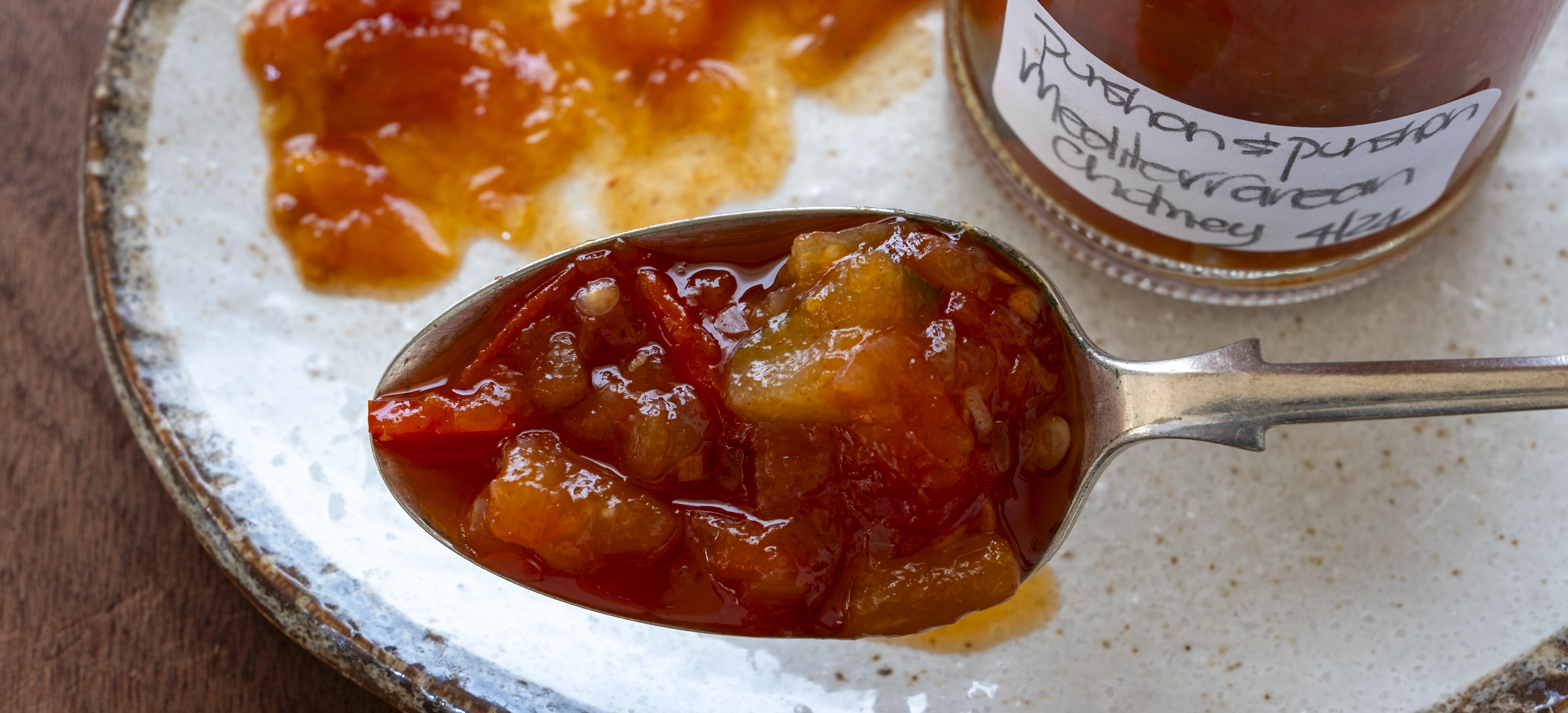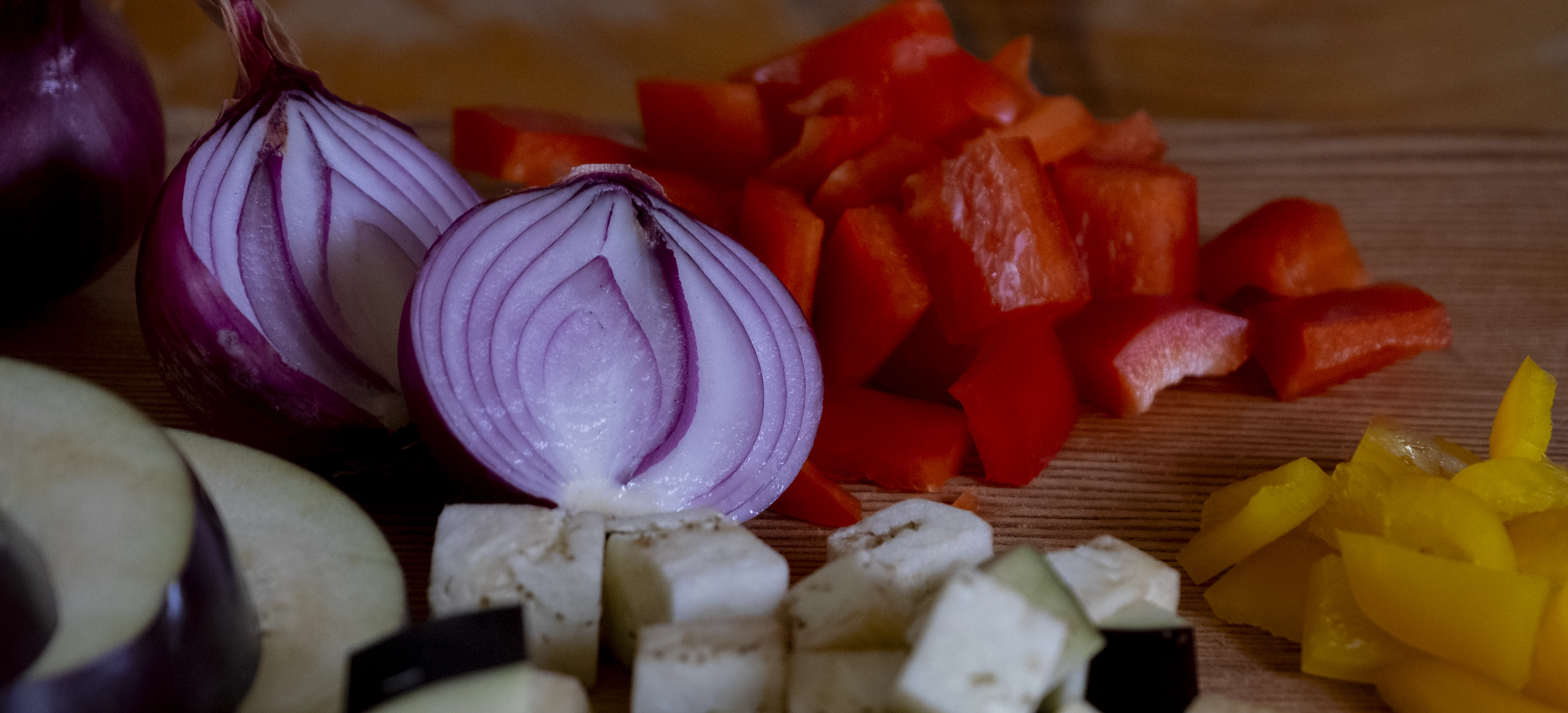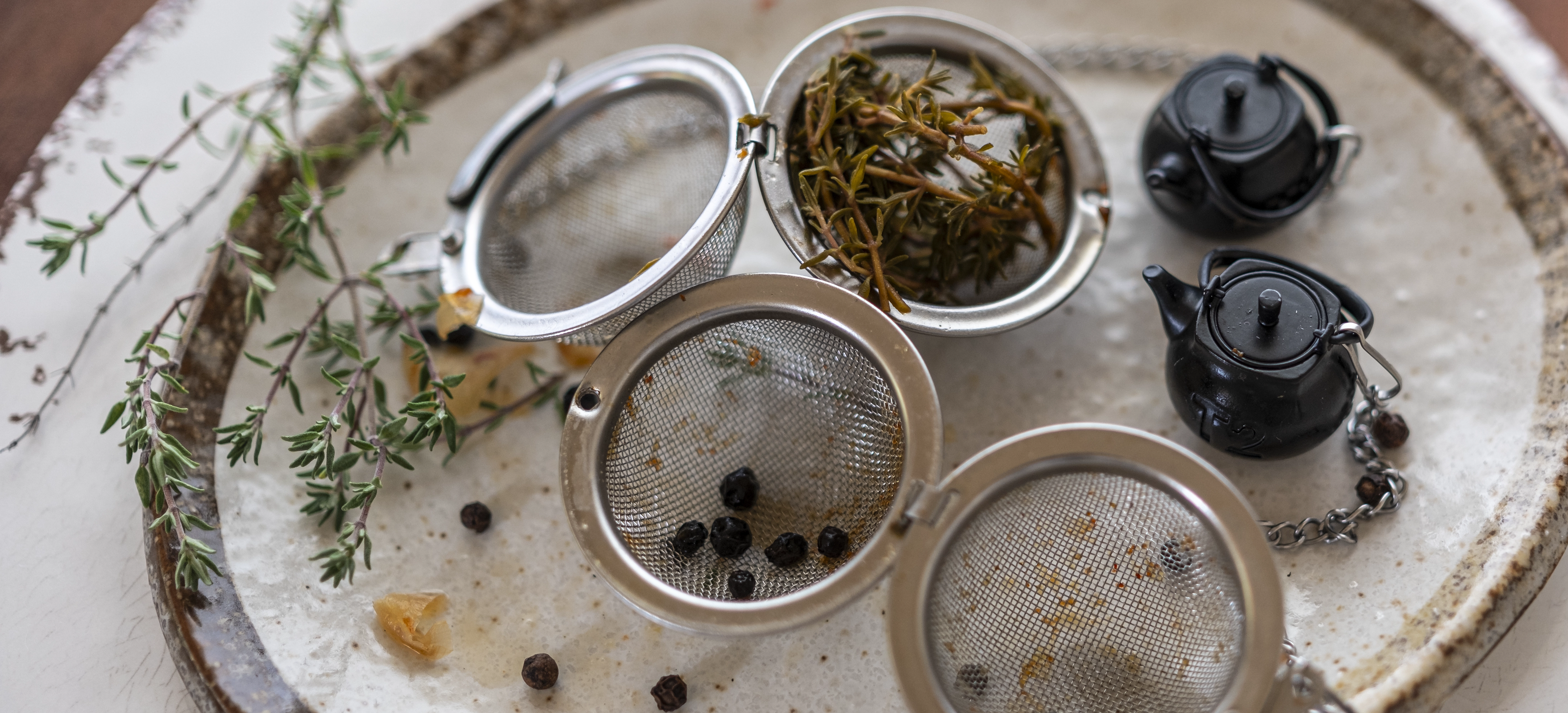Mediterranean Chutney
- Pickles, Chutney, Relish & Sauces

This tomato-based chutney reflects the summer flavours of the Mediterranean. Its bright and lively flavours are the perfect accompaniment to the lighter and more delicate dishes we seek during the warmer months. Diversify your tomato chutney range and add some pizzazz to your summer table. It’s also a handy recipe to use up a bountiful harvest of eggplant, zucchini, and capsicum or to make the most of great seasonal prices. Enjoy preserving the colourful harvest of brilliant reds, purple, greens and yellow.
- Preparation Time:
- 50 minutes
- Cooking Time:
- 1.5 hrs
- Quantity:
- 12 x 325 ml jars
PREPARATION

INGREDIENTS
- 1.8 kg
- Tomatoes, ripe
- 600g
- Eggplant
- 600g
- Zucchini
- 2 medium
- Capsicum, red
- 2 medium
- Capsicum, yellow
- 900g
- Brown onions
- 4, medium
- Garlic cloves,
- 700 ml
- Apple cider vinegar
- 2 teaspoons
- Salt
- 2 sprigs
- Fresh thyme
- 2 sprigs
- Fresh rosemary
- 2 teaspoons
- Sweet paprika
- 1/2 teaspoon
- Black peppercorns, whole
- 700g
- White sugar
METHOD
Wash and gently dry the tomatoes, eggplant, zucchini, and capsicum to remove any shop or garden dust and debris.
To remove the tomato skins. Bring of large pot of water to the boil. While this is heating insert a small sharp vegetable knife a short distance from the stem. Using as slight inward angle cut in a circular motion all around the stem and remove the core. Repeat the process until the stems and cores have been removed from all the tomatoes.
Place several tomatoes, at a time, in a pot of continuously boiling water for approximately 30 seconds. Remove and place in bowl of cold water. This will soften the skin for the next step. Be careful not overcook the tomatoes at this point
Remove the skins, they will slip of easily, and discard. Coarsely chop the tomatoes and put aside.
Trim the ends off the eggplant and zucchini. Leaving the skin on, cut into 1 cm ( ½ inch) cubes and put aside.
Cut the ends off the capsicums, cut in half, and remove and discard the seeds and membrane. Cut into 1 cm (1/2 inch) cubes and put aside.
Peel the onions and cut into the same size as the other vegetables. Peel and finely chop the garlic.
Place the sprigs of thyme and rosemary and black peppercorns into a tea infuser or tie into a spice bag made from piece of muslin or cheese cloth. Refer Notes Section below: How to Make a Spice Bag
Place all the prepared vegetables, salt, and 300 ml of the vinegar into a stainless-steel preserving pan or heavy bottom stainless steel pot. Cover and cook with the lid on very gently for approximately 15 minutes or until the mixture softens and the juices begin to run. If there is insufficient moisture, add 250ml water. This will cook out later, however in the meantime it will ensure there is enough liquid and vinegar to cook the ingredients.
Add the remaining vinegar and sugar, stir to ensure the sugar has dissolved. Simmer with the lid off for approximately 50 minutes or until the vegetables are completely cooked and the chutney has thickened. The chutney consistency test: spoon a little of the mixture on to a plate, the chutney should hold its shape.
Stir occasionally, particularly as the mixture thickens, to prevent the chutney from burning on the bottom of the pan.
Use a funnel to pour into hot dry sterilised screw cap sealable bottles, fill to approximately 2.5cm (1 inch) from the top of the jar and seal with hot dry lids.
Allow to cool and wipe the jars to remove any spills during the bottling stage.
-
Label and store in a cool dark place in the kitchen or pantry.
Allow to mature for at least 4 weeks before eating.
Refrigerate after opening.
NOTES
- Ensure your jars and lids, lined with a protective coating to withstand the corrosive action of the vinegar, are hot and dry at the time of bottling.
- Good quality jars should be used in all preserving, particularly when they are processed in a hot water bath. Thin jars often cannot withstand the temperatures and may crack either in the bath or on and or after removal. Avoid the disappointment and invest in some good jars from a homewares or preserves outlet. Select jars that have non-reactive lids as the vinegar solution can cause the lids to rust over time.
- Choose clean ripe fruit. Do not use overripe and never use mouldy fruit as this will produce a poor-quality chutney.
- If you want a chunkier chutney texture, cut the vegetables into larger pieces. To ensure even cooking and consistency make sure they are all cut to the same size.
- Cooking times are an approximation only. They are provided as a guideline as cooking times are influenced by the type of pot and its diameter and height, speed of cooking and the ripeness, size, and moisture level of the vegetables. Cooking time will depend upon; (1) preserving pan size- the broader the pan, the quicker the evaporation, (2) degree of fruit ripeness- the riper the fruit, the sweeter and juicier the initial chutney will be, (3) cooking heat- the higher the heat, the greater the boil which will produce greater evaporation.
- Type of sugar and vinegar
- The type and colour of the sugar and vinegar used will affect the final colour and flavour of the chutney. Malt vinegar and brown sugar will produce very dark brownish red chutney with a more earthy/molasses background flavour, while white wine vinegar or apple cider and white sugar will produce chutney that has a fresher and brighter tomato flavour. What use use will be influenced by the style of the chutney and your personal choice.
- Take care to only use vinegar which has a 5% minimum acetic acid content. The acetic acid content acts the principal preservative, and any lower quantity will compromise the safety of your preserves. Commercially available vinegar is 5%, however most homemade vinegars do not achieve this level.
- Salt
- Use good quality pickling salt when making pickles and preserves. Many commercial salt brands contain stabilisers and anti-caking agents and often iodide which forms a whitish haze and sediment. These additives and in particular iodine can affect the appearance and taste of pickles and preserves during the maturation and storage period.
- The ingestion of a cocktail of anti-caking chemicals such as calcium silicate, sodium silicoaluminate, tricalcium phosphate, magnesium carbonate, silicon dioxide and yellow prussate of soda, is also unnecessary.
- Read the label before buying and look for salt that is free from any artificial additives. My favourite salt is Olsson Cooking Salt. No commercial benefit is received from Olsson Salt.
- To make a spice bag
- To make the cloth spice bag, drape a square of muslin or calico over a basin. Place the spices and/or herbs outlined in the recipe mixture into the cloth
- Gather up the corners and make a bag by tying it up with kitchen string approximately 2 cm above the fruit. Always allow room between the tie point and spice mixture so the water can bubble through the bag easily. This helps to extract as flavour as possible from the contents.
- Discard the spices, unless otherwise specified in the recipe once the bag has been removed from the preserving pan. Wash, dry, and keep the cloth for the next batch.
- My tea towel draw has a range of different sized cloths that are on hand for my preserving sessions.
- Knowing your herbs and spices
- Garlic (Allium sativum)
- Raw garlic has a sharp acrid taste, however when cooked it takes on a sweeter flavour and is not overpowering. It has the unique ability to heighten the flavour of the ingredients it’s combined with and is indispensable in the kitchen. Interestingly though, the way garlic is prepared will affect its flavour profile.
- There are two types of garlic- hardneck and softneck. Hardnecks grow with a stem that comes from the centre of the bulb and when harvested and cured, the stem becomes rigid and easily identifiable when pulling the cloves off. Softnecks have leaves rather than a central stalk, so there in no rigid stem in the middle of the bulb.
- Fresh garlic should be stored in loose netting or basket in a cool, dry and well-ventilated place. Do not store in a paper bag or the fridge. Garlic’s flavour, pungency and moisture content will deteriorate over time. Dried garlic and garlic powder is available and should be stored in an airtight container.
- Paprika (Capsicum annum)
- Capsicum peppers are harvested in summer and then dried and ground to produce paprika powder. There are two main types: Hungarian which is bright or rust red with a pronounced fruit flavour and Spanish which is darker and sweet. Both are available in mild and hot and smoked forms and are graded on several characteristics which indicates their flavour and heat level.
- Smoked paprika is produced by smoking the capsicum fruit prior to processing and curing.
- Paprika combines well with a wide variety of herbs and spices and is used in many well-known spice blends: tandoori, barbecue, Baharat, Cajun, chermoula, curry, harissa, rase al hanout and tagine spice mixes.
- Paprika is appreciated for its earthy flavour and its rust-red pigment is used to create a rich reddish tone to recipes.
- Paprika powders range from bright red and silky smooth to dark-red and coarse-textured. Smoked paprika should be used more sparingly than non-smoked varieties as the flavour is more intense.
- Other names include hot paprika, Hungarian paprika, mild paprika, ñora paprika, pimento, pod pepper, smoked paprika, Spanish paprika, sweet paprika, sweet pepper.
- Rosemary (Rosmarinus officinalis)
- Rosemary has a fresh, astringent, peppery and a warming woody and herby taste. When its fresh leaves are bruised it produces a pine-like and minty fragrance.
- Dried rosemary retains its pungent, woody and pine-like characteristics but it loses its delightful complex green volatile notes. As it takes a long time to soften during the cooking process, it’s recommended that fresh rosemary is used whenever possible.
- It pairs equally well with fresh and savory dishes. Fresh rosemary should be kept in a vase of water which should be changed every couple of days and not stored in the fridge. Dried rosemary stored in airtight containers away from extremes of heat, light and humidity and will last for 2 years.
- Thyme (Thymus vulgaris)
- A small perennial shrub, indigenous to the Mediterranean. Garden and lemon thyme are the most common and useful culinary varieties. It has a pungent, bittersweet yet warming and aromatic flavour. Traditionally used in savoury dishes it is now increasingly being used in sweet dishes.
- Dried thyme should be stored in airtight container away from heat, light and humidity extremes and should last 2 years. Store fresh thyme in vase of water, in or out of the fridge, and change the water very couple of days. Lemon thyme can be purchased in speciality stores and dried lemon thyme is generally not available.
- In Türkiye, the thyme herb is called zatar, which should not be confused with za’atar which is a blend of spices.
- Although the flowers are tiny, they are numerous and produce copious quantities of pollen making thyme highly attractive to bees. Hymettus honey from Mount Hymettus, near Athens is famous for its characteristic flavour of wild thyme.
- Garlic (Allium sativum)
 Using a tea infuser instead of making a spice bag
Using a tea infuser instead of making a spice bag
